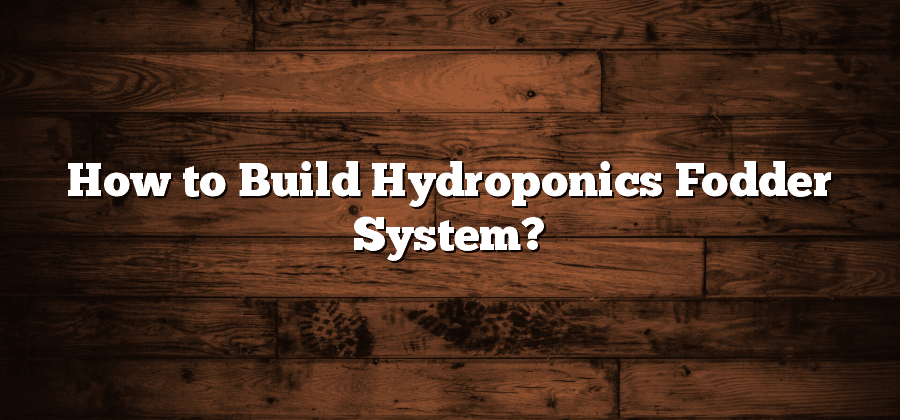Understanding Hydroponics Fodder Systems
Hydroponics fodder systems are a popular and innovative method of growing livestock feed using nutrient-rich water instead of soil. This method allows farmers to produce large volumes of nutritious fodder in a controlled environment, ensuring optimal growth and maximum yields. Understanding the fundamentals of hydroponics systems is crucial for farmers who wish to embark on this sustainable and efficient farming practice.
In a hydroponics fodder system, seeds are germinated in trays or on racks and then placed in a specially designed growing structure. Nutrient-rich water is continuously circulated through the system, providing the plants with the necessary minerals and nourishment for rapid growth. This method eliminates the need for traditional soil-based farming and allows for year-round production, regardless of external weather conditions. By providing a consistent and controlled environment, hydroponics fodder systems enable farmers to produce high-quality feed with minimal resources and waste.
Selecting the Right Fodder System Design
When it comes to selecting the right fodder system design for your hydroponics setup, there are several factors to consider. Firstly, you need to assess the size of your operation and determine how much fodder you need to produce on a daily basis. This will help you determine the capacity of the system you require. Additionally, consider the available space you have for the system and choose a design that fits within these limitations.
Another important factor to consider when selecting the right fodder system design is the type of crops you plan to grow. Different crops have varying nutrient requirements and growth patterns, so it’s crucial to choose a design that can accommodate the specific needs of your chosen crops. Whether you opt for a vertical tower system or a horizontal rack system, make sure it can provide the optimal growing conditions for your selected crops.
In conclusion, selecting the right fodder system design for your hydroponics setup requires careful consideration of factors such as the size of your operation, available space, and the specific nutrient requirements of your chosen crops. By taking these factors into account, you can ensure that your hydroponics fodder system is efficient and productive, enabling you to produce high-quality fodder for your livestock.
Gathering the Necessary Materials and Equipment
When it comes to gathering the necessary materials and equipment for your hydroponics fodder system, it is essential to consider the specific requirements of your chosen design. Different types of hydroponics systems may require different components and tools, so it is crucial to thoroughly research and understand the needs of your selected system. One of the first items on your list should be high-quality seeds that are suitable for hydroponic cultivation. These can be obtained from reputable suppliers or even harvested from previous crops if applicable. Additionally, you will need trays or containers to hold the seeds during germination and growth stages. These can range from simple plastic trays to specialized hydroponic grow trays, depending on your preference and budget.
Aside from seeds and trays, you will also need a nutrient solution for your hydroponics fodder system. This solution provides the necessary nutrients and minerals for the plants to grow healthy and vigorous. It is essential to choose a nutrient solution that is specifically formulated for hydroponic use, as traditional soil fertilizers may not be suitable. These solutions can be purchased from hydroponic supply stores or ordered online. Additionally, you will need a reliable pH meter to monitor and adjust the acidity and alkalinity levels of your nutrient solution. This ensures that the plants are receiving the optimal pH range for nutrient absorption. Other important equipment to gather includes water pumps, air stones, grow lights (if required), and ventilation systems to ensure a controlled and optimal environment for your hydroponics fodder system.
Preparing the Growing Area for the Fodder System
When it comes to preparing the growing area for a hydroponics fodder system, there are a few key steps to follow in order to ensure optimal results. Firstly, it is essential to choose a suitable location that provides the necessary space and access to water and electricity. The area should be well-ventilated and free from pests and diseases that could potentially harm the plants. Additionally, it is crucial to consider the lighting requirements for the hydroponics system, as providing adequate artificial light can be essential for the growth and development of the fodder.
Once the ideal location has been selected, the next step is to prepare the surface where the hydroponic fodder system will be set up. Start by thoroughly cleaning and disinfecting the area to eliminate any potential contaminants. This can be done by using a mild bleach solution or other suitable sterilizing agents. Upon completion of the cleaning process, it is advisable to allow the area to dry completely before proceeding to the next step.
Setting Up the Hydroponics Fodder System Structure
Setting up the hydroponics fodder system structure is a crucial step in ensuring the success of your hydroponic farming venture. This entails setting up the necessary infrastructure and components to support the growth of fodder crops in a soilless environment. To begin, you will need to carefully plan and measure the available space where the hydroponics system will be installed. Whether you are setting up the system indoors or outdoors, it is important to ensure that the space is well-ventilated and receives sufficient natural or artificial lighting.
Once you have determined the ideal location for your hydroponics fodder system, the next step is to assemble the necessary materials and equipment. This includes the construction of the framework that will support the hydroponics trays or channels where the fodder crops will be grown. The structure should be sturdy enough to bear the weight of the growing medium, plants, and irrigation system. Additionally, you will need to install an efficient system for water supply and nutrient delivery. This typically involves a combination of pumps, pipes, and reservoirs to ensure a continuous flow of water and nutrients to the plants.






